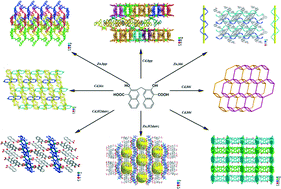Assembly of a series of d10 coordination polymers of pamoic acid through a mixed-ligand synthetic strategy: syntheses, structures and fluorescence properties†
Abstract
Eight mixed-ligand coordination compounds, [Zn(PA)(bpp)]n (1), {[Cd(PA)2(Hbpp)2(H2O)2]·2H2O}n (2), [Zn(PA)(bbi)]n (3), [Cd(PA)(bbi)(H2O)]n (4), {[Cd3(PA)2(bbi)3(Cl)2]}n (5), {[Zn6(PA)5(datrz)2(Hdatrz)2(H2O)2]·16DMF}n (6), [Cd2(PA)(datrz)2(DMF)2]n (7), and {[Cd2(PA)2(bix)2(DMF)2]·4DMF}n (8) (bpp = 1,3-bi(4-pyridyl)propane, bbi = 1,4-bis(imidazol-1-yl)butane, H2datrz = 3,5-diamino-1,2,4-triazole, bix = 1,4-bis(imidazol-1-ylmethyl)benzene), have been synthesized through the reaction of zinc and cadmium salts with pamoic acid (H2PA) and different N-donor ligands. The assembly of the ligands in different coordination modes and conformations leads to fascinating structures. 1 and 3 afford an interpenetrating polythreaded 2D → 3D motif composed of 44 sql undulated sheets, while right- and left-helices are alternatively arranged in 3. 2 possesses an interesting 3-D supramolecular network with 1-D hydrogen-bonded chains spanning different directions. 4 and 5 display both polyrotaxane and polycatenane characteristics. In 4, two 2,4-connected (4·85) nets interlocked with each other, forming a 2D → 2D polycatenating network. 5 exhibits a twofold interpenetrated (3,5,6)-connected (3·5·6)(3·52·67)(32·54·66·72·9) topology. 6 and 7 represent rare pentanodal (3,4)-connected and binodal (3,4)-connected frameworks with topologies of (4·5·6)(4·8·10)(52·6·8·9·11)(4·5·6·8·92)(4·5·7) and (4·6·8)(4·62·83), respectively. 8 displays 3-fold interpenetrated 4-connected SrAl2 topology with flexible bix ligands bridging Cd centers to form right- and left-helices. The mixed-ligand effect of the conformations of the PA ligand and N-heterocyclic coligands as well as the metal centers on the assembly of frameworks is unravelled in detail. Solid-state luminescence properties of all compounds were reported as well. Moreover, fluorescence properties of compounds 6 and 8 in various solvent suspensions at room temperature have also been investigated.


 Please wait while we load your content...
Please wait while we load your content...